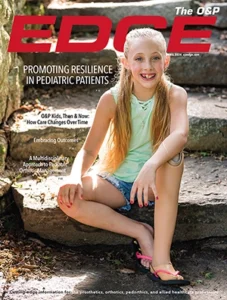My dual training as a physical therapist and as a prosthetist/orthotist has given me the ability to see patients through two overlapping lenses. In 2010, I was contacted by my alma mater, Springfield College, to spearhead a curriculum change in its physical therapy (PT) program. As an adjunct to the gait and movement disorder coursework, they wanted a class specific to O&P but designed for rehabilitation professionals. Think of it as an O&P crash course—action-packed with the essentials for new PT graduates.
After developing the course, which I continue to teach annually, it seemed to be a natural progression for our practice, which utilizes PT and O&P skillsets under one roof, to include post-graduate interns. This way, through these lenses, future providers can gain a greater breadth of understanding about the complexities of patient care. The PT education model brought about a similar relationship with the podiatric medicine residency program at St. Francis Hospital, Hartford, Connecticut.
“Balancing clinical practice and podiatric resident education is best achieved by integrating as many available resources as possible,” says Rafael Gonzalez, DPM, who heads the residency program. “Local or regional hospitals, affiliated out-patient clinics, out-patient surgery centers, private podiatry practices and others such as physical therapists, wound care specialists, etc., should be part of this collective effort. By sharing responsibilities, providers can deliver residents with more comprehensive education and training across interconnected specialties without overwhelming any particular provider with all or most of these responsibilities.” In clinical training, it’s not uncommon for a patient assessment to have Gonzalez, myself, a PT intern, and a handful of podiatric residents in the same room. This yields excellence in care, and eliminates the risk of the patient’s care plan being lost in translation.
The benefits of a robust teaching institution are immeasurable. As small, independent healthcare practices, we shouldn’t shy away from the educational process, or feel only large teaching hospitals can play a role. Small healthcare practices can offer more personalized care and far less red tape. Instead, we can focus our clinical time establishing care plans based on what the evidence recommends. Interns are expected to share how they arrive at a care decision, showcase and share the references, and rigorously evaluate the quality of research. In doing this, we all benefit by melding clinical experience to evidence-based care. An added benefit is that we constantly meet new providers, and can identify the best of the best as well as those that share our patient-first passion. “I’ve been doing this a while; the benefits are endless,” says Gonzalez. “Staying current with all new surgical trends and technological advances in our profession, being able to educate well-trained medical and surgical providers to meet the community’s needs. There is also the satisfaction of teaching, which in my opinion, is an honorable and moral obligation we have to our profession and to those trying to follow in our footsteps.”
This kind of collaboration is a large undertaking, and not for everyone. However, for those who value and enjoy the educational process, I’d recommend starting slow and small. Interject yourself in a local community college or even at the high school level in an observation role. Colleges demand clinical shadowing opportunities, and this is an exciting population to begin with. We are as strong as those with whom we connect. Reach out to your local colleagues and see where your clinical skillset can benefit the community, both patients and those providers in training.
Matt Calendrillo, DPT, BOCO, BOCP, is the cofounder of Live Every Day, with offices in Simsbury, Suffield, Avon, and Westminster, Connecticut. He can be reached at [email protected].




